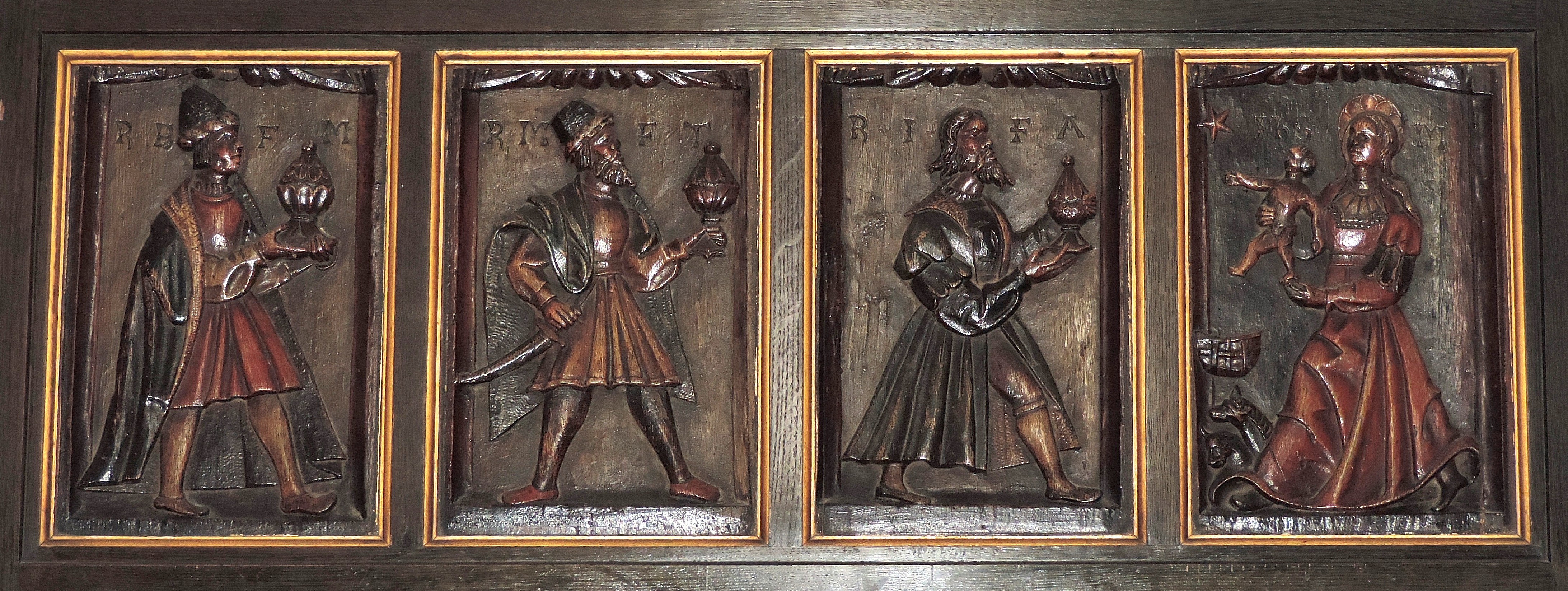The photograph for Christmas this year features four carved panels. These were gifted to the Kirk of St Nicholas by Alexander Yeats, Town Clerk depute at the time of the restoration of St Mary’s Chapel in 1898 for the decoration of St Mary’s Chapel. The subject matter is clearly that of the Adoration of the Magi.

The right hand panel features a standing female holding a young child in her hands. The lettering is rather indistinct, but carved in the upper background to the left is IHS and to the right M. IHS is a common abbreviation seen in many churches, which uses the first three letters of the Greek for Jesus, whilst, more obviously, M stands for Mary. Thus there is no doubt this is Mary and the baby Jesus.
The remaining panels feature the ‘three kings’. It is only Matthew’s Gospel which records the visit of these strangers ‘from the east’, and there is no suggestion there that they were kings. Rather they were likely to be astrologers or priests who studied the skies. The number three is used only because there were three gifts recorded by Matthew. Over the years tradition and legend has developed around them, even to the point of giving them names. In the photograph of the panels, the carved letters suggest that these traditional names can be identified for each panel. From the left they are:
RBFM – Rex Balthazar Ferens Myrrham (meaning King Balthazar bearing the myrrh)
RMFT – Rex Melchior Ferens Thus (meaning King Melchior bearing the frankinsense)
RIFA – Rex Iasper Ferens Aurum (meaning King Jasper bearing the gold)
Note that Jasper is now more commonly called Gaspar or Casper.
The exact history of these panels is still uncertain. They were reported, with drawings, to the Society of Antiquaries of Scotland in 1831 at which time they were part of a door in the parish church of Ruthven near Cullen in Morayshire. That same report suggests that previously they belonged to the Earls of Findlater, whose chief seat was at Cullen. If this latter report is accurate, then it is probable that the panels would, at some time, have been displayed in the ancient Church of Cullen, said to have been founded by King Robert Bruce (but probably older than that). In Cullen there has been a long standing cult of the ‘Three Kings of Cologne’. This was probably linked in some way to the removal of supposed relics of the Magi from Milan to Cologne by Frederick Barbarossa in 1164. There is a small but elaborate shrine in Cologne Cathedral said to contain the relics. In mediaeval times, Cullen was spelt Cullane – and so the similarity with Cologne becomes clearer and it could have given rise to confusion. There was also a mediaeval Mystery Play called ‘The Three Kings of Cullane’. To complicate matters there are three rocks in Cullen Bay knows as ‘the Three Kings of Cullen’, but their naming is linked to the death locally of three kings in battle not the biblical characters. Given these links and traditions, it would have been fitting for these panels to have ornamented the early church in Cullen. However, the true origin for the panels remains a mystery. Their style is European and would suggest an early date. This is consistent with them dating back to mediaeval times, perhaps in Germany, but nothing is certain.
The OpenSpace Trust wish you all a very Happy Christmas as we celebrate the birth of Jesus.